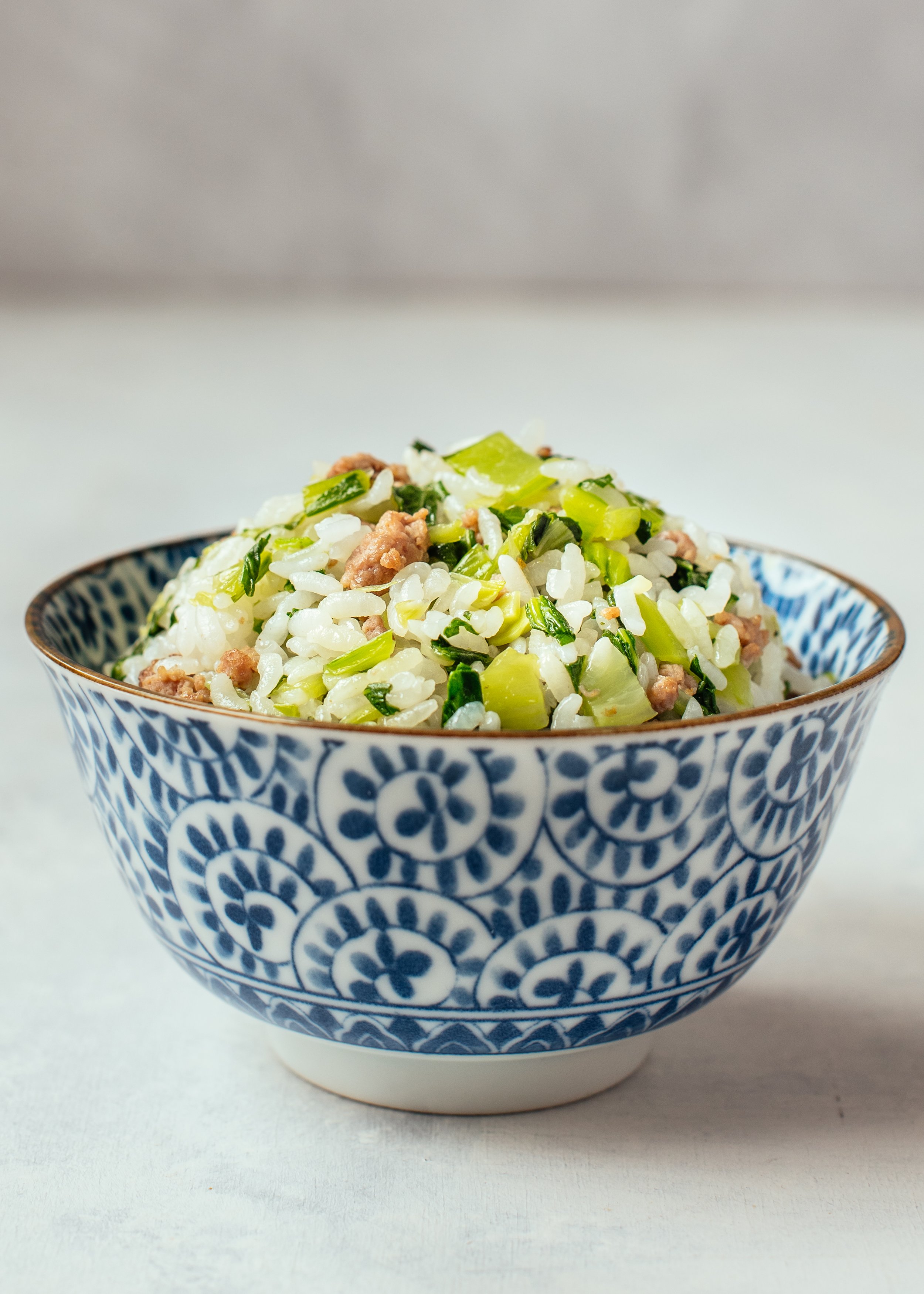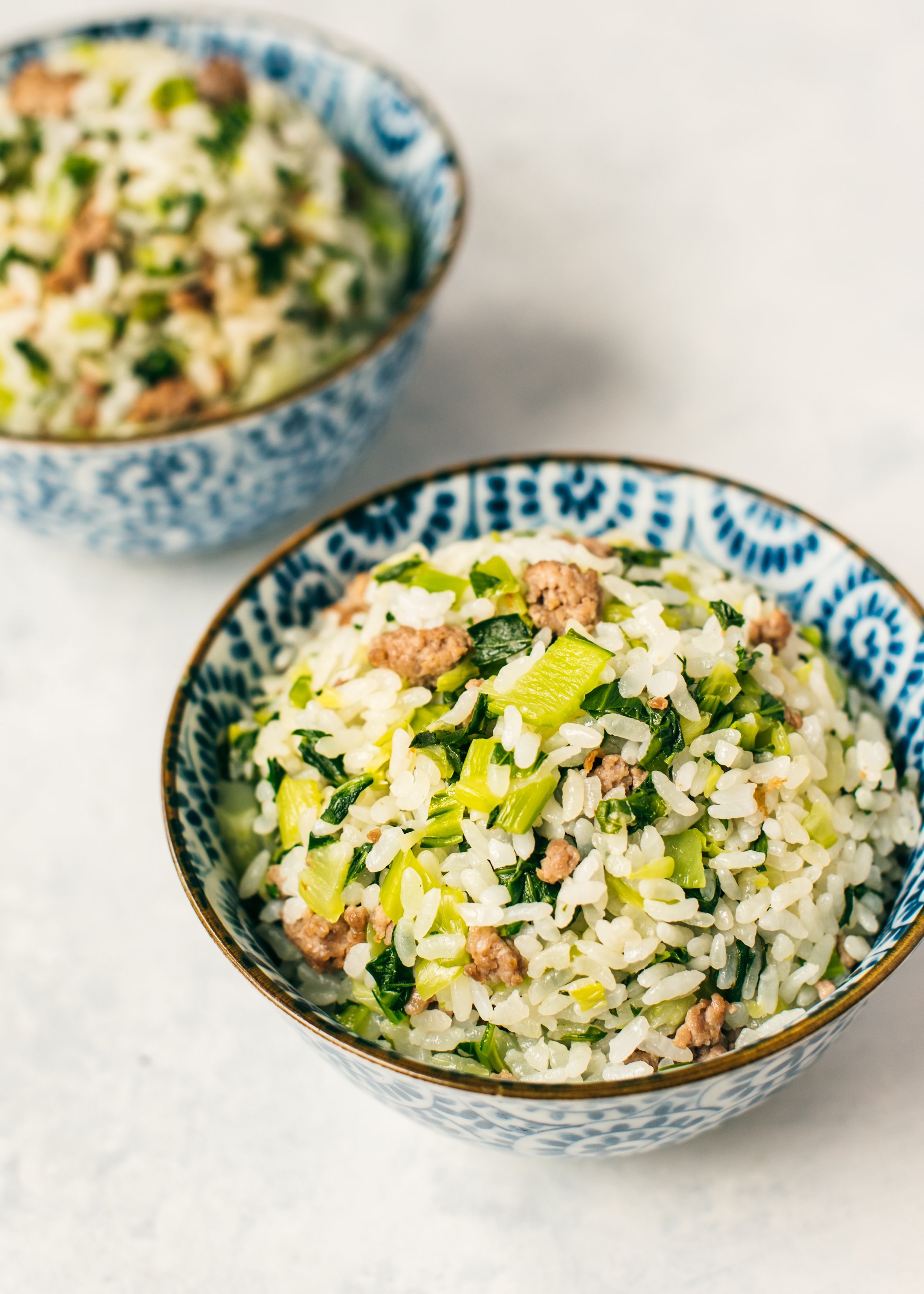Shanghai Vegetable Rice ( 上海菜飯 )
This Shanghai Vegetable Rice is a simple comfort food of my childhood, the kind of humble home cooking I love. It has loads of leafy greens. It is comforting and nutritious, and a one-and-done kind of meal. My favourite kind.
Interestingly, in spite of this being called Shanghai Vegetable Rice, this dish typically involves a little bit of Chinese salted meat (“ham yuk” or 鹹肉) or Chinese sausage (“lap cheong” or 臘腸) to flavour the dish. However, since those are not widely accessible to everyone here, I use organic ground pork which isn’t authentic to the dish but is easy (no cutting!) and loved by my family. Occasionally, I’ve used a little bit of Italian pancetta to impart that salt-cured pork flavour if I happen to have some in the fridge. Feel free to sub with a different ground meat if you don’t eat pork.
For a meatless version, we swap in diced shiitake mushrooms for the umami ingredient in place of meat (see recipe Head Note 4 below).
🎥 Watch video for Shanghai Vegetable Rice
It may surprise you that this veggie-loaded rice is very well liked by children too! My younger one gets prepaid hot lunch at her school but always asks for a portion of this to bring for lunch the day after we had this for dinner. FYI…fellow parents.
I’m so excited to share this, the third of a recipe series on my Instagram, You Got This in 30 Minutes, wherein each recipe is family-friendly and can be made in 30 minutes (or less). I try to keep the recipes in this series simple, and this one is no exception - involving only 5 ingredients (excluding salt and oil). I’m so pleased with the amazing response to the first two recipes from the series so far and have linked them below in case you’re interested. Let me know in comments what you think of this recipe or if you have any questions!
Eat well and be well.
Sonia
You may also be interested in these other recipes from the same 30-minute recipe series:
》Mushroom and Egg “Gyudon” Rice Bowl
》Easy Chinese Tomato Egg Noodle Soup
Tips for Shanghai Vegetable Rice
How to properly prepare rice: Wash uncooked rice by gently rubbing grains against each other with your hand while swirling it in water. I do this directly in a fine-mesh colander or you can wash the rice in the cooking pot filled with water and pour out water several times. Do this until water runs clearer but does not need to be fully transparent. Drain well and place in pot. Add appropriate amount of water:
For long-grain rice (such as jasmine), use 1:1 rice-to-water ratio. For this recipe, add 2.5 cups water
For short-grain rice (such as Japanese sushi), use approximately 1:1.25 rice-to-water ratio. For this recipe, add 3 cups water
Soaking short grain rice: If using short grain rice, it is optional but ideal to soak it in the measured water before cooking – anywhere between 10 to 60 minutes. OK so yes, this step technically makes this recipe more than 30 minutes but it is passive time. Continue to cooking step once it has soaked the amount of time you can spare. You do not need to soak long grain rice.
Sauté bok choy until most of the liquid evaporates: Greens like bok choy release a ton of liquid when cooked. During the sautéing step, make sure to move them around and use high enough heat evaporate most of the liquid before adding cooked rice. Otherwise, the rice will absorb the liquid and get soggy.
Recipe Notes for Shanghai Vegetable Rice
1. WHAT KIND OF RICE SHOULD I USE? Long-grain jasmine rice is the default in Chinese meals but I actually love using short-grain (sushi) rice in this recipe for its chewier texture as pictured in this blog post. Either will work. Since this recipe involves only a few ingredients, it’s important to make sure the rice is cooked properly aka not soggy and not undercooked. In particular, take care to measure the grains and water with accuracy. I’m obsessed with rice and am sure I could write a whole post just on cooking rice but for now, make sure to follow my recipe instructions on rinsing, soaking (for short-grain rice) and cooking.
2. WHAT IS THE DIFFERENCE BETWEEN BOK CHOY AND SHANGHAI BOK CHOY? Shanghai bok choy has pale green stems and smooth pale green leaves. Regular bok choy has white stems and curlier, dark green leaves. In taste, Shanghai bok choy is slightly sweeter while regular bok choy is more verdant. They are similar enough to be used interchangeably in most recipes. Use your favourite in this dish or whichever is fresher at the store. You can also use either the “baby” smaller bok choy plants or the full sized bok choy in this recipe since they get chopped finely.
3. SUBSTITUTES FOR THE GROUND PORK. Chinese salted pork (“haam yuk” or 鹹肉) is the traditional meat to use but I use ground pork for two reasons: (1) It is widely accessible at conventional grocery stores. (2) Ground meat in general is one of my favourite weeknight shortcuts because it doesn’t require any prepping whatsoever which saves a TON of time. ALTERNATIVES TO GROUND PORK: ground chicken OR pork tenderloin cut into 1/4” cubes. Another great substitution is Italian pancetta cut into 1/4” cubes (in which case omit the soy sauce and salt marinade). See note 4 below for meatless version.
4. CAN THIS BE MEATLESS? YES. In fact, my family often made a meatless version of this dish, with shiitake mushrooms. Dehydrated shiitake mushrooms (rehydrated overnight in fridge to use) are more flavourful but you can use milder, fresh shiitake mushrooms too. Chop shiitakes into small 1/4” dice and cook them until tender, then mix them in instead of ground pork in the recipe.
SHANGHAI VEGETABLE RICE 上海菜飯
If you made this or enjoy the content, please consider a star rating and/or adding a comment below. I love to know what you guys think. If you have a question about the recipe, drop it in the comments - I’m always happy to help!















Hi, I’m Sonia
I share recipes inspired by my food cravings and what I make for my family. My role as a working mom of two girls, my life in Toronto Canada and my background as a Chinese immigrant from Hong Kong all inform the things I love, crave and create. This means an emphasis on wholesome recipes that are approachable for busy weeknights and fun recipes to make on weekends and for friends!
homemade food to nourish and indulge …
More about Sonia >